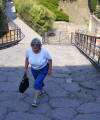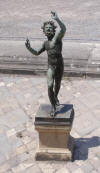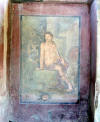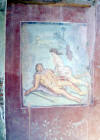


Holiday at Hotel Alpha, Sant'Agnello, near Sorrento.
Friday 24th June - Friday 8th July 2011 Visit to Pompeii Roman Site
Home Sorrento Day 1 - 4 Day 5 - 7 Day 8-10 Day 11 - 15 Herculaneum Villas
Pompeii stands on a plateau formed from volcanic lava. This 60 hectare site dominates the surrounding plain and descended naturally from north to south. To the south, the plateau overlooks the River Sarnus, a navigable river allowing ships to dock just outside the city walls. When Vesuvius erupted in 79 AD the city was covered in layers of ash and lapilli (small particles of volcanic material varying in size from a pea to a walnut). Further discharges continued with an ultimate discharge of a thick stream of pyroclastic material, extremely hot and lethal. Many who had survived the earlier discharges were now engulfed and covered in further layers of dust and ash to a depth of about 6 metres. Recovery of belongings and artefacts began almost at once, not always by the proper owners. In time the site reverted to nature and the site was covered in more windblown debris or dust and vegetation. Since excavation started in 1748, about two thirds of the site has been uncovered and the remainder has been left for future generations. Systematic excavation began between 1863 and 1875 under G Fiorelli.
Porta Marina - the entrance to Pompeii up the original road from the dock through a gatehouse with 2 entrances - pedestrian and other traffic. The slope is quite steep.
Within about 50 metres one arrives at the Forum to the left, with the Temple of Jupiter at the far end. The Forum is lined with important government and commercial buildings on three sides. There was a Basilica (2nd Century BC), a temple to Apollo. At the north end arches flank the Temple of Jupiter. The arches would have been covered in marble decorations.

 An important commercial building was the Macellum or Food
Market
An important commercial building was the Macellum or Food
Market
On the opposite side of the Forum is a building which was unfinished when the eruption struck. It was to house warehouses and the grain market. Now it is used to store finds from the excavations.
Building as it is now Plaster cast of former inhabitant Ceramic finds including amphora.
All the streets were paved and most had raised side pavements and stepping stones at major junctions. There were water supply fountains scattered around the city. Some buildings were covered in writing - either as advertisements or graffiti. There are many repairs or restorations being done all around the city so fencing is necessary.
On the south eastern edge of the city there was a complex that we now know as the Triangular Forum, which included a small Doric temple, together with a large theatre and a smaller theatre (now called The Odeon) and a small gladiators' barracks.
Large Theatre Gladiators' Barracks Small Theatre
There were several types of commercial premises servicing the population and scattered around the city.


 The laundry used stale urine as a
bleaching/cleaning agent as it contained ammonia.
The laundry used stale urine as a
bleaching/cleaning agent as it contained ammonia.


 Bakeries usually ground the flour onsite
using rotary querns driven by donkey or mule.
Bakeries usually ground the flour onsite
using rotary querns driven by donkey or mule.

 There were many bars and fast food shops.
There were other shops as well.
There were many bars and fast food shops.
There were other shops as well.

 The amphitheatre was located at the eastern
corner of the city. It one of the first in the Republic , being built not long
after 80BC
The amphitheatre was located at the eastern
corner of the city. It one of the first in the Republic , being built not long
after 80BC

 The House of Venus in the Shell has some
very nice wall paintings.
The House of Venus in the Shell has some
very nice wall paintings.

 The House of the Faun has some outstanding
mosaic floors including the battle scene with Alexander and the small bronze
statue of the faun is a fine bronze in the centre of the impluvium.
The House of the Faun has some outstanding
mosaic floors including the battle scene with Alexander and the small bronze
statue of the faun is a fine bronze in the centre of the impluvium.

 The House of Loreius Tiburtinus has some
nice wall paintings and also had a very good garden, with central water channel
and other decorations and planting.
The House of Loreius Tiburtinus has some
nice wall paintings and also had a very good garden, with central water channel
and other decorations and planting.
 Corpses were buried in tombs or mausoleums
built along the road outside the city gates. This outside Porta Ercolana.
Corpses were buried in tombs or mausoleums
built along the road outside the city gates. This outside Porta Ercolana.
The Villa of Mysteries is situated outside the city walls past the Ercolano Gate. It is a large villa with some fine wall paintings and a large shady peristyle.
Front Loggia or Peristyle Painted wall plaster in a Salone.